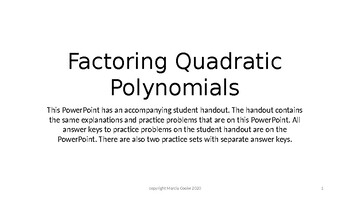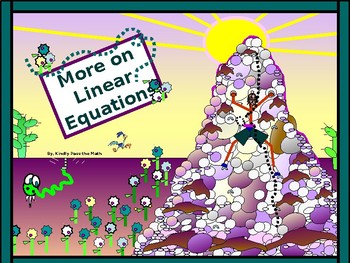9 results
11th grade algebra homeschool curriculum interactive whiteboards
1:03
Area Model (BOX) Method Positive Binomials (4x + 12)(x + 6)
The area model method is multiplying two expressions that have two terms each, such as (4x + 12)(x + 6). The box method helps you to organize the terms and avoid mistakes when applying the distributive property. To use the area model method, you need to follow these steps: - Draw a 2 by 2 box and label the rows and columns with the terms of the binomial. - Fill in each cell of the box with the product of the corresponding row and column terms. - Add up all the terms in the box and combine any
Subjects:
Grades:
8th - 12th, Higher Education, Staff
Also included in: Multiplying Binomials FOIL and Area Model Method Examples

Algebra Power-Point: Slope-Intercept form/DISTANCE LEARNING/NO PREP
Students always seem to enjoy the lessons on Slope-intercept form.
* Within the slides, students receive instruction on exact meanings for each term in the slope-intercept equation.
* They review how to manipulate an equation from other forms to find the desired slope-intercept form.
* Once they master the basics, they learn what to do with the information and graph it on the Cartesian plane.
* Since the lesson greatly involves the slope, students learn about the relation
Subjects:
Grades:
7th - 11th, Higher Education, Adult Education
CCSS:
Also included in: BUNDLE: Algebra Power-point Graphing Linear Equations and Functions

Power-Point:Solving Multi-Step Equations in AlgebraDISTANCE LEARNING NO-PREP
WELCOME TO KINDLY PASS THE MATH!!!* The following power point resource explains how to solve equations with more than one step by using your students' newly acquired skills in combining like terms, applying the distributive property, and using the reciprocal to solve, as needed. * There are two examples of Real-Life problems on calculating the volcanic depth of the Earth when given the temperature at a specific depth. * Included in the resource, students solve five practice problems in or
Subjects:
Grades:
7th - 11th, Higher Education, Adult Education
CCSS:

Quadratic Sequence - High School Digital Math Lesson and Activities
In this lesson, learners will be able to recognize and use quadratic sequences. They will also be able to deduce expressions to calculate the nth term of quadratic sequences.Lessons can be used as whole class teaching by teachers and at home by learners.This lesson contains lots of drag and drop activities with instant feedback. Contains 30 Interactive pagesTo open this lesson you need to unzip or extract the files.Choose index.html to view onlineYou can also view this lesson offline.
Subjects:
Grades:
8th - 11th

Algebra Power-Point: Ratios and Rates in Algebra/DISTANCE LEARNING/NO PREP
Ratios and Rates offers instruction for students on Key terms: ratio, rate, unit rate, and unit analysis.
* In alignment with common-core standard, students solve Real-life problems converting US dollars to pesos.
* Students calculate ratios and write them three different and acceptable ways.
* They calculate unit rates and learn the difference between a ratio and a rate.
* They calculate a rate from collected data, and they use "Unit Analysis" to make conversions bet
Subjects:
Grades:
7th - 11th, Higher Education, Adult Education

GEOMETRY PP: Quadrilaterals, and Parallelograms/DISTANCE LEARNING/NO PREP
* Students will enjoy the geometric basics in this presentation as they gradually embark upon valuable material intended to provide support in daily assignments and assessments.
* Students learn about the meaning of the word polygon, concave and convex polygons, vertices, the parts of a polygon including the difference between "regular" and "irregular" polygons.
* Students learn the difference between "equi-angular" and "equi-lateral" polygons
* Students become familiar with the variou
Grades:
8th - 11th, Higher Education, Adult Education
CCSS:

Factoring Polynomials
This unit contains a PowerPoint with practice problems and answer keys. The content defines all vocabulary related to factoring and polynomials and presents the following techniques: Factoring quadratic trinomials with a leading coefficient of 1 and those > 1 •Recognizing and factoring out common factors. •Factoring polynomials with four terms. •Recognizing and applying perfect square patterns in factoring. •Factoring higher degree polynomials.Determining which polynomial
Grades:
8th - 12th, Adult Education
CCSS:

Math Lab: 45-45-90 triangles and circle puzzle/DISTANCE LEARNING/NO PREP
* A collage of a circle and a square is presented; diagonals are inserted. * A chart below the figures is given for students to fill in the measurements of each segment and/or circumference based on one given value. * The puzzle is quite the challenge, but can be a rewarding activity to complete especially if students compete with one another in class to see who can fill the table fastest and most accurately. * Additionally, the puzzle can be used as an extra credit project when they fin
Subjects:
Grades:
10th - 12th, Higher Education, Adult Education
CCSS:
Also included in: BUNDLE: 45-45-90, 30-60-90, CIRCLE AND SQUARE PUZZLES

Algebra Power-Point: More on Solving Linear Equations/DISTANCE LEARNING/NO PREP
"More on Solving Linear Equations" places a more intense challenge before the student who is learning to solve Linear Equations.
* Students become more fluent in the use of inverse operations
* Students apply the distributive property, and isolating the variable.
* Students enjoy their newly acquired ability to solve more complicated problems in algebra.
* Students apply the lesson to real-life situations involving a situation with rock climbing.
* This power point is aligned with
Subjects:
Grades:
7th - 11th, Higher Education, Adult Education
CCSS:
Showing 1-9 of 9 results





